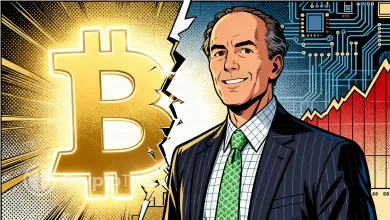Arthur Hayes Claims That Banks Embrace the Debasement Trade

- Arthur Hayes says banks now push Bitcoin and gold as part of the debasement trade.
- Bitcoin’s fixed supply makes it a strong shield against the fall of fiat currencies.
- Market data indicate that BTC and gold are moving in tandem as global debt levels rise.
Traditional finance is shifting focus toward what Arthur Hayes calls the “debasement trade,” an investment strategy centered on tangible assets such as Bitcoin and gold. The BitMEX co-founder stated on X (formerly Twitter) today that it took nearly two decades for legacy institutions to recognize crypto’s potential as a hedge against fiat erosion. Hayes’ statement aligns with rising awareness of currency debasement, as global debt levels and inflationary pressures reshape asset allocation strategies.
Hayes described the “debasement trade” as a portfolio shift toward limited-supply assets—including Bitcoin, gold, and tech stock derivatives—designed to counter government debt expansion and currency decline. He argued that banks are now positioned to offer these assets to clients as macroeconomic hedges. “Don’t believe for a second they will forget about it,” Hayes warned, suggesting the shift is structural rather than temporary.
Bitcoin as a Hedge Against Fiat Devaluation
Arthur Hayes does not regard Bitcoin as a speculative instrument but rather as a long-term insurance policy against currency devaluation. The coin’s total supply of 21 million is in stark contrast to the unlimited issuance of fiat money, which central banks increase in times of economic downturns. Hayes associates Bitcoin’s value with actual energy and production; thus, he views it as “stored energy,” rather than an intangible digital asset.
This interpretation elevates Bitcoin beyond mere price speculation, providing it with a foundation in economic productivity and scarcity. He argues that continuous monetary expansion weakens fiat currencies while amplifying the value of hard-cap assets like Bitcoin. He cites market data showing that even as traditional assets rise in nominal dollar terms, Bitcoin’s performance outpaces them when adjusted for gold.
Market Data Supports the Narrative
The argument made by Arthur gets substantiated by the evidence from top financial sources. Bloomberg has, most recently, stated that Bitcoin has a new record high price and the inflows were linked to the “debasement trade” narrative. The tactic is to buy up assets with hard limits, digital scarcity, and anti-inflation characteristics so as to preserve value as fiat weakens.
JPMorgan analysts also indicated that gold and Bitcoin are in the same frame, speculating that Bitcoin remains undervalued when viewed in the light of gold and could potentially reach a mark of $165,000 under certain conditions. Meanwhile, macroeconomic indicators suggest that the U.S. national debt has nearly reached $38 trillion and is growing by $6 billion daily, intensifying the debate on the viability of fiat currency.
Related: Arthur Hayes Predicts Trump Shaping Fed Policy by 2026
The transition is also supported by the actions of investors. There have been reports of substantial investments in Bitcoin, gold, and silver, which have been influenced by factors such as inflation, currency depreciation, and political instability. NewHedge reports that the relationship between Bitcoin and gold has been getting stronger since 2022. Their 30-day rolling correlation data reflects both assets moving up together, with Bitcoin crossing $100K and gold being at about $2.5K.
Source: NewHedge
Institutional Shifts and the Road Ahead
Hayes’s remarks and recent market data point toward an institutional realignment. The “debasement trade” is no longer confined to retail crypto traders; it is entering mainstream finance. Analysts suggest that traditional financial companies may wrap up new investment products, among which ETFs and structured derivatives will be the ones to give exposure to both crypto and precious metals.
To prove Hayes’ theory, experts propose keeping an eye on the institutional future allocations to crypto, adjustments of central bank reserves and rates of gold accumulation. An increase in these signs could indicate that the debasement trade is not simply a trend but a profound change in the market that reshapes the very manner in which global capital seeks refuge from inflation and debt-ridden economies over a long period of time.





